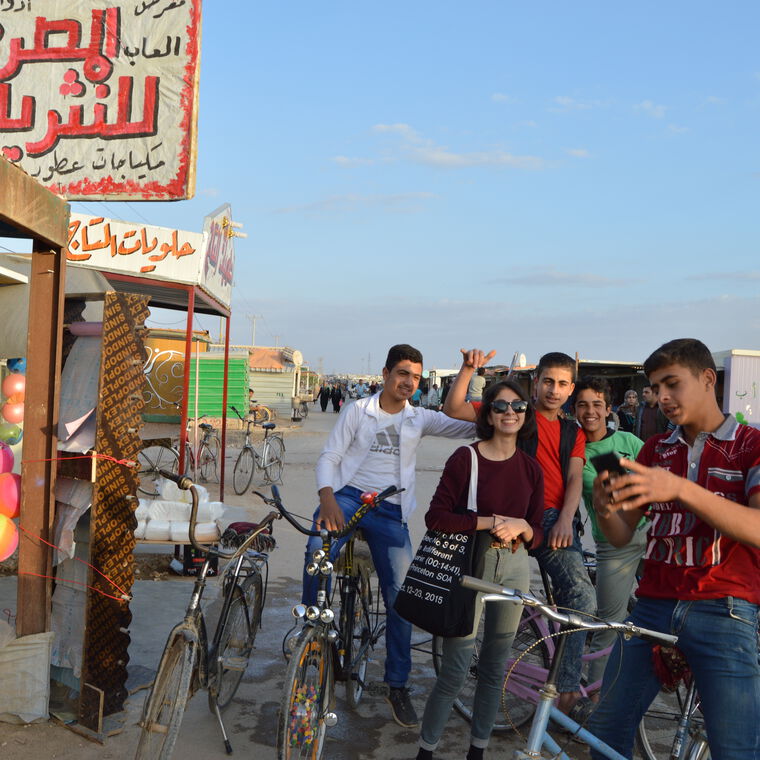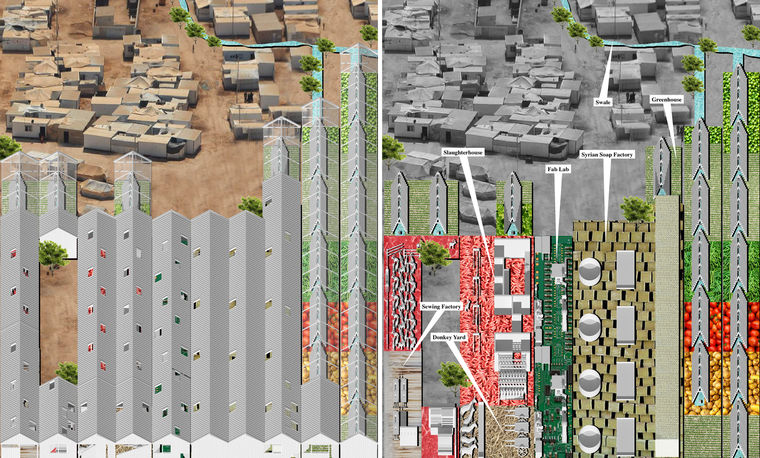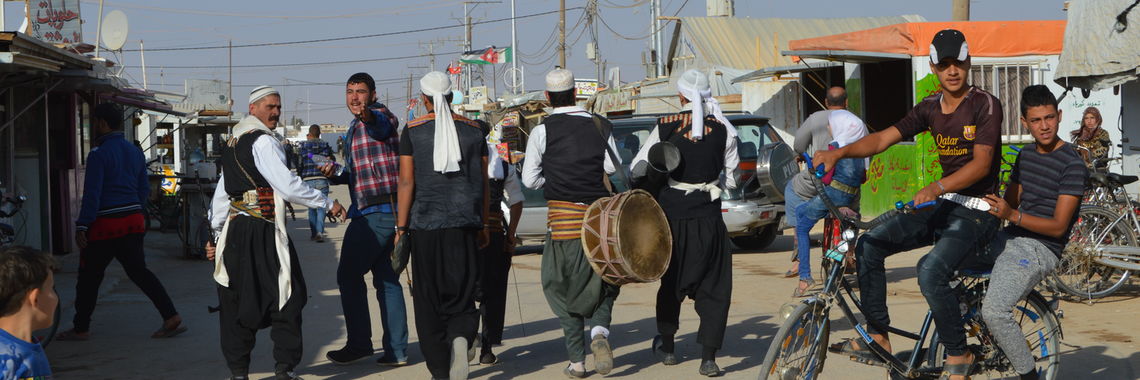P.D. Soros Fellowship for New Americans
If you are an applicant and need to sign into the online application, you can find the link on the "Apply" page of our website: Apply Page.
If you are a fellow looking to login, please note that we are currently updating our backend system for managing Fellow data. In the meantime, to update your information for the Fellowship, please send updates to Nikka Landau at nlandau@pdsoros.org.
Leen Katrib’s Architectural Plans For Refugees Receives International Recognition
-

Leen Katrib (center) on a visit to the Zaatari refugee camp in Jordan.
Having grown up in the United Arab Emirates and being the daughter of Syrian and Lebanese immigrants, 2016 Paul & Daisy Soros Fellow Leen Katrib has always been interested in refugees. After all, many of her loved ones and her own family has had to relocate to new countries because of socio-political circumstances beyond their control. As an architecture graduate student at Princeton, she is now studying architecture as it relates to immigrants and refugees in the United States and abroad. Her memory of the architectural, economic, and social inequalities between Sharjah’s concentration of forced migrants and Dubai’s rapid urbanization developed her passion in architecture and urbanism. Fearing forced relocation back to Syria, Leen and her family moved to West Virginia when she was 14 years old to pursue permanent legal presence for the first time.
Her proposal for the Zaatari refugee camp in Jordan received honorable mention in the inaugural Place and Displacement competition hosted by Ideation Worldwide. The competition sought proposals that looked at refugee camps and architecture that could support refugee market activities. The competition received more than 300 proposals from 700 participants from 43 countries, and there was only one winner and one honorable mention for the Zaatari refugee camp.
-

Images from Leen Katrib's proposal.
Leen, congratulations! What an interesting competition to take part in. How did you decide to focus on the Zaatari refugee camp?
I came across a paper recently published by two professors of economics from Oxford. They proposed to integrate Syrian refugee workers into Special Economic Zones (SEZs) that are being built throughout Jordan. They cited Zaatari refugee camp as a pilot program due to its close proximity to a nearby SEZ called King Hussein Bin Talal Development Area (KHBTDA). Their proposal gained political traction and was discussed at the London Conference on Syria in 2016, which led to the Jordan-EU agreement to jumpstart the program. After tracking employment statistics in Jordan and meeting with officials from Jordanian government ministries and KHBTDA, there was enough evidence to show that their proposal faces many practical obstacles. Nevertheless, their proposal did prompt me to look into the idea of coupling SEZ laws with the untapped economic potential of Syrians in Zaatari.
You focused on marketplaces within the camp. What did you want to focus in on in your proposal?
Rather than continuing to build at the scale of a small marketplace in the camp or integrating Syrians from Zaatari into the nearby special economic zone, I wanted to focus on transforming the unoccupied perimeter of the camp into a special economic belt of production and trade facilities that can be built, led, and operated by the Syrians themselves. This provides them the opportunity to generate income and to be single-handedly involved in deciding how to build and alter their facilities to fit various program specificities.
What type of research did you do to prepare for the proposal?
Most of the information about the camp’s security and the laws for product exchange between the camp and the host country is very inconsistent and skewed from what I saw in person. As such, it was important to communicate with primary sources. I reached out to and met with public and private sector entities in Jordan who gave me the inside scoop on the current standing of the Jordan-EU deal and the planning of Zaatari. Much of my research dealt with understanding policies of production and trade, and finding common threads between KHBTDA’s industry-sectors and existing small businesses in Zaatari’s marketplace. I also studied the camp’s existing resources that could be utilized in building large-scale operations. For instance, I tracked storm water and grey water flows in the camp to determine where hydroponic greenhouse caravans can be efficiently implemented.
How did your own family’s experiences help you in the process?
I used to visit my family in Syria every summer, so I’m aware of many cultural specificities and practices common to Syrians. Farming is a really important and common practice there; I have many memories of spending time in my grandpa’s farm in Syria. And I saw a direct translation of that in how Syrians were able to hack Jordan’s dry desert soil and plant anything with very little resources in the back of their caravans.
Some of the families I met in Zaatari told me that they took the initiative of ripping out the original wood flooring of the donated caravans and pouring concrete, because they clean their floors with water and a squeegee, and wood is not an appropriate material. And that’s such an interesting detail that immediately puts into question the potential architectural transformation of the generic caravan and the universal refugee camp model to reflect cultural specificities. Pouring concrete is technically illegal in what the host country considers to be a “temporary” camp, as concrete suggests permanence. But the families did it anyway and the government didn’t stop these interventions.
What was your favorite aspect of your proposal?
The proposal builds upon the already existing Do-It-Yourself culture in Zaatari’s marketplace, where many Syrians built small businesses of every industry sector imaginable. My favorite aspect are the many loopholes and maneuvers the proposal suggests to expand the small businesses to the scale of production and exchange facilities that can be led and operated by the Syrians themselves. The proposal also underscores that Syrians lead the operations, which is an important distinction from the proposal by the two Oxford professors. If their proposal were to be successfully implemented, Syrians from Zaatari would be one of thousands working long hours in large factories and facing potential human rights exploitations often associated with Special Economic Zones that are operated by large foreign corporations.
What’s next for you in your architecture practice?
I will be going back to Jordan briefly this summer to meet with public sector entities about potentially starting a pilot program in Zaatari. Aside from that, I’m looking into current heritage conservation practices with regards to the destruction of UNESCO sites in Syria, and the potential role of collective memory in rethinking the heritage project. ∎
© 2024
